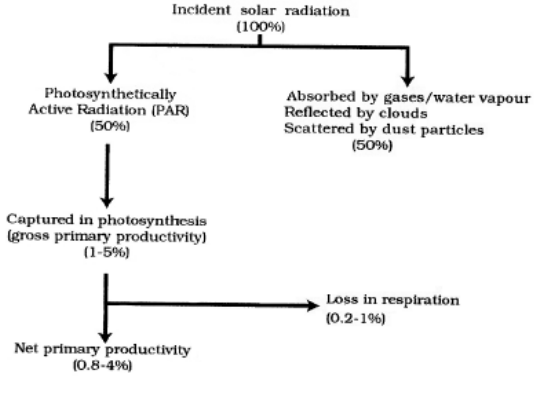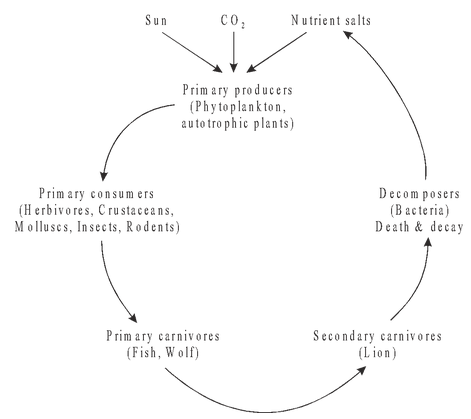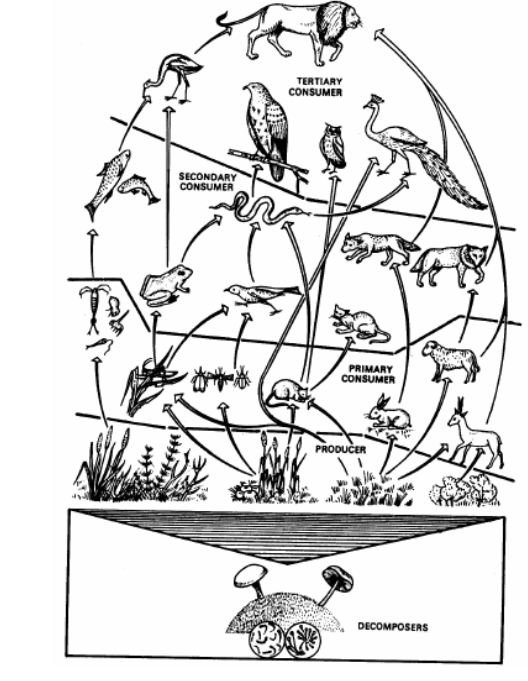
Energy flow in ecosystem pdf
Ecosystem of Class 12
Energy flow is the key function of an ecosystem.It is determined by two basic laws of thermodynamics.
- First law of thermodynamics
- Second law of thermodynamics
First law of thermodynamics
It states that energy is neither created nor destroyed, but can be transferred from one component to another, or transformed from one state to another.
Second law of thermodynamics
It states that every energy transformation involves degradation or dissipation of energy from a concentrated to a dispersed form due to metabolic functions, so that only a small part of energy is stored in the biomass.
Light falling on the plants is trapped by the producers in the presence of Mg++containing green pigment called chlorophyll and is used in assimilating the organic food called glucose by the process of photosynthesis. By photosynthesis, radiant energy of sunlight is transformed into potential energy of foodstuffs. Evidences show that only a part of energy is trapped by the producers while the rest of energy is dissipated.
The energy conserving efficiency is– 1.15% for grasslands, 0.9% for Savannah, 0.8% for mixed forests, 5% for modern crops and 10-20% for sugarcane field. The green plants or producers breakdown a part of organic food in respiration to obtain chemical energy for various body functions and overcoming entropy. Dissipation of energy occurs as heat. The remaining energy is used in the synthesis of plant biomass called net photosynthesis which is then available to the next trophic level of food chains. This loss is not due to the inefficiency of the photosynthetic mechanism of the plants but due to the operation of second law of thermodynamics.
The total biomass manufactured by plants during photosynthesis is called gross primary productivity of an ecosystem and is symbolized as PG. On average, it is about 1-5 percent energy of incident radiations, i.e. 2-10 percent of photosynthetic active radiation (PAR). A part of it is used by the plants themselves for respiration (R), while the remaining biomass is called net primary productivity (PN). It is also called apparent photosynthesis. On average, it is about 0.8-4 per cent energy of incident radiations, i.e. 1.6-8 per cent of PAR. So it can be represented as PN = PG – R.

Fig. : Fate of solar radiation incident on plant canopy
(Values in Parentheses represent fraction of incident solar radiation)
Related Topics
FOOD CHAIN
A food chain is simply a feeding relationship in which food energy is transferred from a given source through a series of species each of which eats the one before itself in the chain. This repeated series of eating and being eaten is always initiated with green plants. Green plants receive their energy from the sun.
A very simple food chain may be represented as :

Each successive level of nourishment as represented by the links of the food chain is known as trophic level . Plants form the first trophic level namely the producer trophic level. Then come the consumer levels . These comprise the herbivores (the primary consumers), the carnivores and parasites (secondary and tertiary consumers etc.).
At each level when the energy transfer occurs, a large proportion of the potential energy present in the chemical bonds of the food species is lost as heat. Because of this phenomenon the number of steps in a food chain is, usually, limited to four or five. It has been found that the shorter the food chain (or the nearest the organisms is to the beginning of the chain) the greater the available energy that can be converted into biomass (living weight) utilised in cellular respiration.

In a two-step food chain of more of the potential energy initially available per unit of corn reaches man than if the corn is fed to pigs and the swine are eaten by man (Fig.).

Fig. : Food chain
TYPES OF FOOD CHAINS
- Parasitic food chains
- Grazing food chains
- Detritus food chains
Grazing food chain It starts from green plants and ends with carnivores passing through herbivores.
Detritus food chain The organic wastes, exudates, and dead matter derived from the grazing food chain are generally termed detritus. The energy contained in the detritus is not lost to the ecosystem; rather it serves as the source of energy for a group of organisms (detritivores) which constitute the detritus food chain.
In the predatory type of food chains smaller organisms are eaten by larger organisms. In the parasitic food chains largest organisms are eaten by smaller species. The term saprophytic is given to a food chain where dead organic matter is fed upon by fungi such as mushrooms and finally bacteria.
EXAMPLES OF SOME COMMON FOOD CHAINS
Food Chains on Land
- Grass → Grass Hopper → Frog → Snake → Peacock/Falcon
- Vegetation → Rabbit → Fox → Wolf → Tiger
- Vegetation → Insect → Predator Insect → Insectivorous Bird → Hawk.
Food Chains in Water (Pond)
- Phytoplankton → Zooplankton → Small Crustaceans → Predator Insects → Small Fish → Larger Fish → Crocodile.
- Phytoplankton → Zooplankton → Small Crustaceans → Predator Insects → Small Fish → King Fisher/Stork.
FOOD WEB
Food web is a network of food chains which become interconnected at various trophic levels so as to form a number of feeding connections amongst the different organisms of a biotic community. A food web is simply the total set of feeding relationships in a biotic community. The advantage of having such complex web of feeding relationships in the community is that it gives stability to the ecosystem. Even if one or more of these relations is altered, the community will remain stable.

Fig. : Food web in a grassland ecosystem
ENERGY FLOW MODEL
- First, the energy flows one way, i.e., from producers through herbivores to carnivores; it cannot be transferred in the reverse direction.
- Second, the amount of energy flow decreases with successive trophic levels.Producers capture only a small fraction of solar energy (1-5 per cent of total solar radiation), and the bulk of unutilised energy is dissipated mostly as heat.
Part of the energy captured in gross production of producers is used for maintenance of their standing crop (respiration) and for providing food to herbivores (herbivory).
The unutilised net primary production is ultimately converted to detritus, which serves as energy source to decomposers.Thus, energy actually used by the herbivore trophic level is only a small fraction of the energy captured at the producer level.On an average, in different ecosystems, the herbivores assimilation or productivity approximates 10 per cent of gross productivity of producers.




